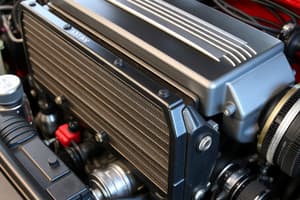Podcast
Questions and Answers
What is the function of the radiator in a vehicle's cooling system?
What is the function of the radiator in a vehicle's cooling system?
- To regulate the flow of coolant through the engine
- To cool down the hot water and air mixture that flows through it (correct)
- To control the opening and closing of the coolant flow
- To mix water and ethylene glycol to prevent freezing
What is the purpose of coolant in a vehicle's cooling system?
What is the purpose of coolant in a vehicle's cooling system?
- To cool the engine by exchanging heat with the air
- To regulate engine temperatures and protect components from corrosion and freezing (correct)
- To open and close based on the engine's temperature
- To manage the flow of coolant through the radiator
What is the role of a thermostat in an automotive cooling system?
What is the role of a thermostat in an automotive cooling system?
- To regulate the flow of coolant through the engine
- To cool down the hot water and air mixture that flows through it
- To open and close based on the engine's temperature (correct)
- To mix water and ethylene glycol to prevent freezing
Which component is responsible for dissipating heat from the hot water and air mixture in a vehicle's cooling system?
Which component is responsible for dissipating heat from the hot water and air mixture in a vehicle's cooling system?
What is the responsibility of the water pump in a vehicle's cooling system?
What is the responsibility of the water pump in a vehicle's cooling system?
Which component is activated by the thermostat when the engine temperature rises?
Which component is activated by the thermostat when the engine temperature rises?
What role does the thermostat play in the vehicle's cooling system?
What role does the thermostat play in the vehicle's cooling system?
Which component is primarily responsible for enhancing heat dissipation by increasing air circulation over the radiator?
Which component is primarily responsible for enhancing heat dissipation by increasing air circulation over the radiator?
Flashcards are hidden until you start studying
Study Notes
Exploring the Cooling System: Radiator, Coolant, Thermostat, Cooling Fan, and Water Pump
Auto cooling systems, crucial for maintaining the optimal performance and longevity of your vehicle's engine, involve a complex network of components that work together to regulate and dissipate heat. In this article, we will delve into the five key components that form the basis of a reliable automotive cooling system:
- Radiator
The radiator is responsible for cooling down the hot water and air mixture that flows through it. It does this by sending the liquid through a series of thin, flattened tubes (called fins) that dissipate heat as air flows over them. The heat exchanged with the air helps lower the temperature of the liquid, which then gets reintroduced into the engine to keep its internal temperature at an optimal level.
- Coolant
Coolant, also known as antifreeze, is a mixture of water and ethylene glycol (or propylene glycol) that helps regulate engine temperatures while protecting the cooling system components from corrosion and freezing. Coolant plays an essential role in maintaining the stability of the liquid's temperature and providing optimal heat transfer properties.
- Thermostat
The thermostat is a temperature-sensitive valve that opens and closes to control the flow of coolant through the engine cooling system. When the engine reaches its optimal operating temperature, the thermostat opens, allowing coolant to flow through the radiator and cool the engine. When the engine temperature drops below its threshold, the thermostat closes, conserving heat and preventing the engine from overcooling.
- Cooling Fan
The cooling fan is a mechanical or electrically-driven device that increases air circulation over the radiator to enhance heat dissipation. When the engine's temperature rises, the thermostat signals the cooling fan to turn on, helping to maintain the optimal engine temperature.
- Water Pump
The water pump is responsible for circulating coolant through the engine's cooling system. It is driven by the engine's belt system and forces coolant through the radiator, engine block, and other critical components. The water pump plays a vital role in ensuring efficient heat transfer and consistent engine temperatures.
Each of these components is essential for maintaining the stability and longevity of your vehicle's engine. Regular maintenance and check-ups will help ensure that your cooling system is functioning as it should. Common issues that might arise include leaks, a malfunctioning thermostat, a worn-out water pump, or a clogged radiator.
By having a solid understanding of the cooling system's components and their functions, you'll be better equipped to diagnose and resolve any issues that might arise. Always consult your vehicle's owner's manual for guidance on proper maintenance and troubleshooting tips, as different vehicles may require specific care to maintain optimal performance.
Studying That Suits You
Use AI to generate personalized quizzes and flashcards to suit your learning preferences.



